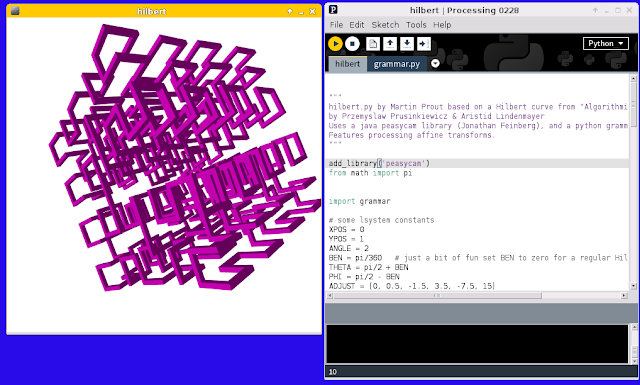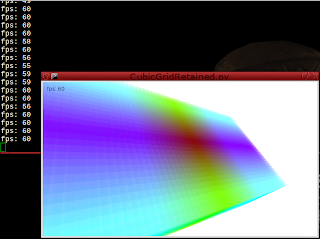1 '''
2 A wireframe box with colored edges which expands and contracts according
3 to time-of-day.
4 An original implementation of *hms* from http://www.gysin-vanetti.com/hms
5 (C) Ben Alkov, 2014, licensed as APL 2.0 as part of processing.py
6 (https://github.com/jdf/processing.py).
7 '''
8
9 def settings():
10 size(500, 500, P3D)
11 smooth(4)
12
13 def setup():
14 global fillCube, edgeCube
15 frame.setTitle("Box Clock")
16 camera(0, 0, 100,
17 0, 0, 0,
18 0, 1, 0)
19
20 # Creating a **filled** wireframe cube is non-obvious.
21 # We need an opaque black cube inside a transparent wireframe cube.
22 fillCube = createShape(BOX, 2)
23 edgeCube = makeEdgeCube()
24
25 # The fill color here has to match the `background` from `draw` in order
26 # for the fill cube to be invisible.
27 fillCube.setFill(color(10))
28
29
30 def draw():
31 rotateX(sin(frameCount * 0.008))
32 rotateY(cos(frameCount * 0.008))
33
34 # The fill color here has to match the `fillCube`'s `setFill` color in
35 # order for the fill cube to be invisible.
36 background(10)
37 drawShape()
38
39
40 def drawShape():
41 # `map`; "Re-maps a number from one range to another."
42 # Scale time units to 3D coordinates.
43 x = map(second(), 0, 59, 1, 12)
44 y = map(minute(), 0, 59, 1, 12)
45 z = map(hour(), 0, 23, 1, 12)
46
47 scale(x, y, z)
48 shape(fillCube, 0, 0)
49 shape(edgeCube, 0, 0)
50
51
52 def makeEdgeCube():
53 # Draw a 2x2x2 transparent cube with edges colored according to the
54 # current time.
55 Red = color(255, 137, 95) # Seconds.
56 Green = color(176, 255, 121) # Minutes.
57 Blue = color(56, 76, 204) # Hours.
58 edgeCube = createShape()
59 edgeCube.beginShape(LINES)
60
61 # Seconds - lines along `x`.
62 edgeCube.stroke(Red)
63 edgeCube.vertex(-1, 1, 1)
64 edgeCube.vertex(1, 1, 1)
65 edgeCube.vertex(-1, -1, 1)
66 edgeCube.vertex(1, -1, 1)
67 edgeCube.vertex(-1, -1, -1)
68 edgeCube.vertex(1, -1, -1)
69 edgeCube.vertex(-1, 1, -1)
70 edgeCube.vertex(1, 1, -1)
71
72 # Minutes - lines along `y`.
73 edgeCube.stroke(Green)
74 edgeCube.vertex(-1, 1, 1)
75 edgeCube.vertex(-1, -1, 1)
76 edgeCube.vertex(1, 1, 1)
77 edgeCube.vertex(1, -1, 1)
78 edgeCube.vertex(1, 1, -1)
79 edgeCube.vertex(1, -1, -1)
80 edgeCube.vertex(-1, 1, -1)
81 edgeCube.vertex(-1, -1, -1)
82
83 # Hours - lines along `z`.
84 edgeCube.stroke(Blue)
85 edgeCube.vertex(-1, 1, -1)
86 edgeCube.vertex(-1, 1, 1)
87 edgeCube.vertex(1, 1, -1)
88 edgeCube.vertex(1, 1, 1)
89 edgeCube.vertex(1, -1, -1)
90 edgeCube.vertex(1, -1, 1)
91 edgeCube.vertex(-1, -1, -1)
92 edgeCube.vertex(-1, -1, 1)
93 edgeCube.endShape()
94 return edgeCube
Static sketches including "size" as might be expected do not play too well.
Second Coming For Processing.py
Wednesday, 4 November 2015
A Third Coming for processing.py (a little unexpected)
Well it seem much kudos must go to Luca Damasco (Google Summer of Code student), the python mode has returned for processing-3.0 . I've just playing with it and it seems to be it might be as well to adopt an approach similar to that I settled on for JRubyArt, and explicitly create a settings method as below, and to set the sketch title in setup:-
Monday, 9 June 2014
Testing recursion limits python mode in the processing ide
Python is well known for not dealing with recursion too well, it seems python mode in the processing mode is even worse:-
To get python syntax highlighting in jEdit with the *.pyde file add the following to the mode catalog:-
1 """
2 spiral.pyde python mode sketch
3 features fairly extreme recursion for
4 python hence we try increase limit
5 but it doesn't work so we capture error
6 """
7 MAX_RECURSION = 1000
8
9
10 def setup():
11 """
12 processing setup
13 """
14 size(400, 400)
15 translate(100, 330)
16 rotate(0.3)
17 fill(255, 0, 0, 0)
18 background(0)
19 noStroke()
20 smooth()
21 fill(255, 0, 0, 20) # transparency makes for almost '3d' look
22 import sys # increase recursion limit or sketch will fail
23 sys.setrecursionlimit(MAX_RECURSION)
24 try: # handle potential index error
25 shell(-0.008, 1.5, 25)
26 except RuntimeError:
27 print "Sketch exceeds set recursion limit"
28 else:
29 pass # Sketch finishes before recursion limit is reached
30
31
32 def shell(rot, disp, sz):
33 """
34 Recursive shell shape limited by sz
35 """
36 REDUCE = 0.999
37 MIN_SIZE = 0.8 # about right for processing
38 if (sz > MIN_SIZE):
39 sz *= REDUCE
40 disp *= REDUCE
41 translate(disp, 0)
42 rotate(rot)
43 ellipse(disp, 0, sz, sz)
44 return shell(rot, disp, sz) # recursive call
45 else:
46 return # break recursive loop on size
47
To get python syntax highlighting in jEdit with the *.pyde file add the following to the mode catalog:-
1 <?xml version="1.0"?>
2 <!DOCTYPE MODES SYSTEM "catalog.dtd">
3
4 <MODES>
5
6 <!-- Add lines like the following, one for each edit mode you add: -->
7 <!-- <MODE NAME="foo" FILE="foo.xml" FILE_NAME_GLOB="*.foo" /> -->
8
9 <MODE NAME="processing.py" FILE="python.xml" FILE_NAME_GLOB="*.pyde" />
10 </MODES>
The latest way to import a java library processing python mode
What you need to do is place the library folder (from vanilla processing) in a libraries folder (under PythonMode), on linux this is sketchbook/modes/PythonMode/libraries/peasy/library/peasycam.jar.
The latest python processing way of calling libary is as for vanilla processing to use the processing menu add library method, which adds the following to your sketch add_library('peasycam')

I have since updated many more of my processing.py examples to run using the latest python mode in the processing ide.

I have since updated many more of my processing.py examples to run using the latest python mode in the processing ide.
Monday, 21 April 2014
Running hilbert fractal sketch in the processing ide
Here is an example of a python sketch running from the processing ide. The main applet file has the .pyde extension whereas other file can have the regular .py extension.
the grammar file gets compiled and stored locally grammar$py.class
Performance is acceptable (significantly less good than ruby-processing), much better than pyprocessing. For more info on scope of processing.py see FAQ here. In summary no SciPy no Numpy but yes to java libraries.
Performance is acceptable (significantly less good than ruby-processing), much better than pyprocessing. For more info on scope of processing.py see FAQ here. In summary no SciPy no Numpy but yes to java libraries.
Friday, 4 April 2014
Is the latest realisation for processing.py
Upate 8 June 2014
Some people (in the academic world, Golan Levin for one) seem to be pretty excited about the python mode in the processing ide, and this time it is being developed by Jonathan Feinberg.
There are significant limitations to working in the processing ide with both languages (and even java processing for that matter). Which is why Jonathan is still offering a standalone processing.py.
Ruby-processing is quite heavily embedded in the ruby eco-system (all jruby compatible gems are available, in addition to most java and processing libraries), and is likely to remain somewhat separate from the ruby mode in the processing ide (which is currently in development by Tyfkda).
Some people (in the academic world, Golan Levin for one) seem to be pretty excited about the python mode in the processing ide, and this time it is being developed by Jonathan Feinberg.
This week, @pheinberg is ensconced in the quiet @fathominfo studio and is up to no good. Python + Processing? Mmm! pic.twitter.com/0GE4BIexyB
— Ben Fry (@ben_fry) April 3, 2014
Before you know it there will be a ruby mode for processing. May'be that might help ruby get some traction in the academic world (where "Windows" reigns supreme, even in bloody China, but probably not in Brazil). Ruby has been notoriously unix centric (and benefits from the rational file structure and many damn useful unix tools) and for that reason some people find it difficult to use ruby on windows.There are significant limitations to working in the processing ide with both languages (and even java processing for that matter). Which is why Jonathan is still offering a standalone processing.py.
Ruby-processing is quite heavily embedded in the ruby eco-system (all jruby compatible gems are available, in addition to most java and processing libraries), and is likely to remain somewhat separate from the ruby mode in the processing ide (which is currently in development by Tyfkda).
Wednesday, 11 September 2013
Macro and Console Commando Files for jEdit
Now you can use jEdit as your ide for processing.py development get the macro and commando files here and here. In my previous posts I included use of a range of processing libraries (toxi, generative design etc). Jonathan Feinberg wouldn't touch them with a barge pole being vehemently anti GPL. However he has made it relatively easy to use the contributed libraries just copy them to processing.py libraries folder (pity he couldn't pick them up from where they get installed by regular processing as we do in ruby-processing). Proof that it all works here for code see previous posting or get it from github here:-


Saturday, 6 April 2013
Using retained shape for performance in processing.py
1 # CubicGridRetained 2 # 3 # You may need to increase the maximum available memory 4 # by passing -mx1000m to jvm (in run script if you use that) 5 # 6 BOX_SIZE = 20 7 MARGIN = BOX_SIZE * 2 8 DEPTH = 400 9 boxFill = None 10 grid = None 11 fcount = 0 12 lastm = 0 13 frate = 0 14 FINT = 3 15 16 def setup(): 17 size(640, 360, P3D) 18 frameRate(60) 19 noSmooth() 20 noStroke() 21 global grid 22 grid = createShape(GROUP) 23 24 # Build grid using multiple 25 for i in range(-DEPTH / 2 + MARGIN, DEPTH / 2 - MARGIN, BOX_SIZE): 26 for j in range(-height + MARGIN, height - MARGIN, BOX_SIZE): 27 for k in range(-width + MARGIN, width - MARGIN, BOX_SIZE): 28 # Base fill color on counter values, abs function 29 # ensures values stay within legal range 30 boxFill = color(abs(i), abs(j), abs(k), 50) 31 sz = [BOX_SIZE, BOX_SIZE, BOX_SIZE] 32 cube = createShape(BOX, sz) 33 cube.setFill(boxFill) 34 cube.translate(k, j, i) 35 grid.addChild(cube) 36 37 def draw(): 38 background(255) 39 40 hint(DISABLE_DEPTH_TEST) 41 42 # Center and spin grid 43 pushMatrix() 44 translate(width / 2, height / 2, -DEPTH) 45 rotateY(frameCount * 0.01) 46 rotateX(frameCount * 0.01) 47 global grid 48 shape(grid) 49 popMatrix() 50 51 hint(ENABLE_DEPTH_TEST) 52 global fcount, lastm, frate 53 fcount += 1 54 m = millis() 55 if (m - lastm > 1000 * FINT): 56 frate = float(fcount) / FINT 57 fcount = 0 58 lastm = m 59 print("fps: %d" % frate) 60 61 fill(0) 62 text("fps: %d" % frate, 10, 20) 63

Subscribe to:
Comments (Atom)
